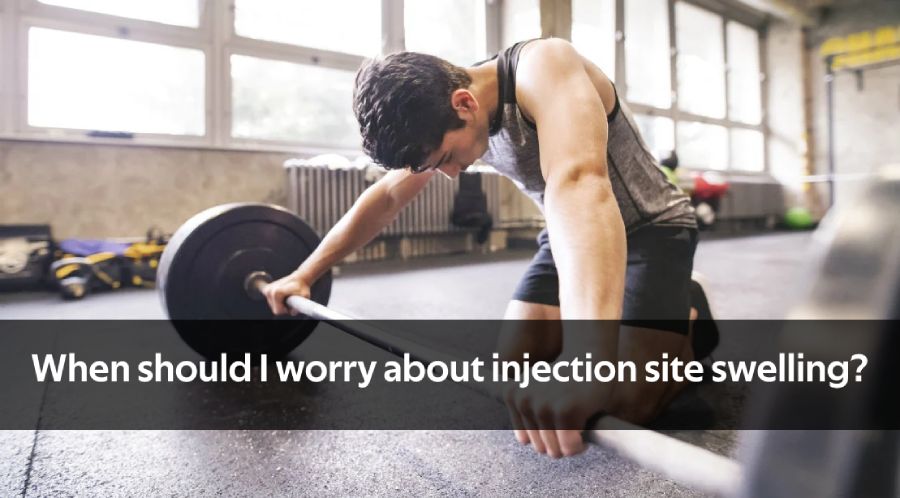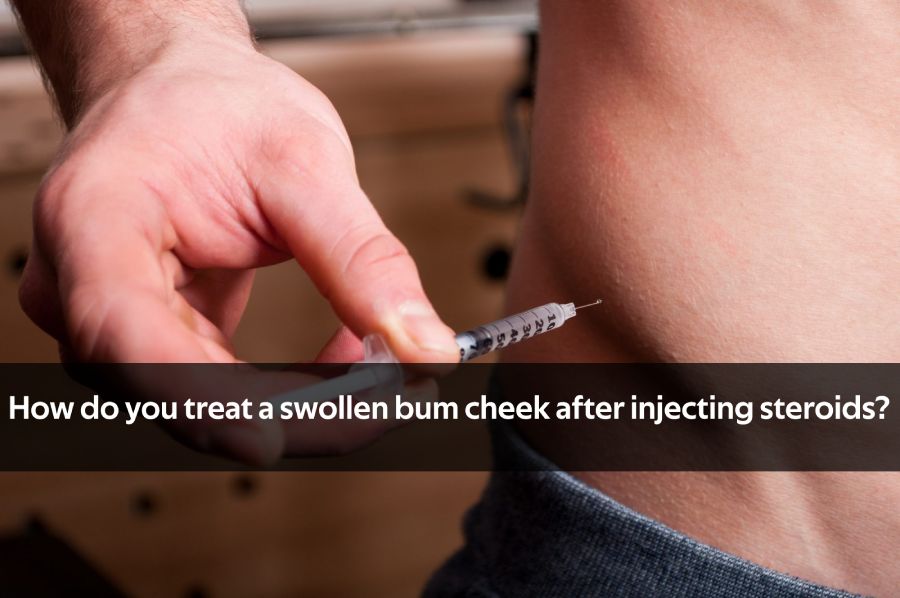How do you treat a swollen bum cheek after injecting steroids?
If you're an avid bodybuilder, you might know that injecting steroids can cause swelling or inflammation at the site of injection. This is not an uncommon occurrence and can be a result of several factors, such as using a dull needle, injecting into a vein, or injecting too much oil into the muscle. A swollen bum cheek after injecting steroids can be uncomfortable and, if not treated properly, can lead to more severe complications.
The first step in treating a swollen bum cheek after injecting steroids is to apply a cold compress to the affected area. This will help reduce inflammation and pain. You can use a cold pack or a bag of ice, wrapped in a towel or cloth, and apply it to the swollen area for 15 to 20 minutes at a time, several times a day.
Another effective treatment for a swollen bum cheek after injecting steroids is to take a nonsteroidal anti-inflammatory drug (NSAID), such as ibuprofen or aspirin. These medications can help reduce inflammation, swelling, and pain. It's essential to follow the recommended dosage and not exceed the recommended amount to avoid potential side effects.
In some cases, the swelling and pain associated with a swollen bum cheek after injecting steroids may be due to an infection. If you suspect an infection, it's essential to see a doctor immediately. They may prescribe antibiotics to treat the infection and prevent it from spreading. Ignoring an infection can lead to more severe complications, such as an abscess.
Rest is also crucial when it comes to treating a swollen bum cheek after injecting steroids. Avoid any strenuous activity or exercise that may put pressure on the affected area. Take some time off from your bodybuilding routine until the swelling and pain subside.
Why is my buttocks swollen after steroid injections?
When bodybuilders inject steroids, there can be several side effects, including swollen buttocks. Swelling, redness, and soreness can occur around the injection site, commonly known as a "steroid injection site reaction." Swollen buttocks after steroid injections can be caused by a variety of factors, such as the injection technique, the type of steroid used, and the dosage.
One common cause of swollen buttocks after steroid injections is an improper injection technique. If the needle is not inserted deep enough or is inserted at the wrong angle, the steroid may be injected into the subcutaneous fat layer instead of the muscle, which can cause swelling and inflammation. It is essential to follow proper injection technique to avoid this type of reaction.
Another cause of swollen buttocks after steroid injections is the type of steroid used. Some steroids are more likely to cause injection site reactions than others. For example, testosterone enanthate and testosterone cypionate are known to cause more pain and swelling than other steroids. Choosing a different type of steroid or adjusting the dosage may help alleviate this issue.
The dosage of the steroid used can also contribute to swollen buttocks after injection. If a higher dose than necessary is used, it can cause more inflammation and swelling. Reducing the dosage or spreading it out over multiple injections can help alleviate these symptoms.
In some cases, swollen buttocks after steroid injections can be a sign of an infection. If the area around the injection site becomes warm to the touch, red, and tender, it is essential to seek medical attention as soon as possible. Infections can be serious and require immediate treatment.
Is it normal to have a lump after injecting steroids?
When it comes to injecting steroids, it's common to experience some discomfort or pain in the injection site. However, if you notice a lump forming under the skin or a swollen area, it could be a sign of a more serious issue. It's important to understand why this happens and what you can do to prevent or treat it.
One possible reason for a lump after injecting steroids is that the injection was not done correctly. If the needle is not inserted at the right angle or depth, it can cause tissue damage and inflammation, leading to a lump. Additionally, using a dull or contaminated needle can introduce bacteria into the tissue, causing an infection.
Another reason for a lump could be due to the steroid itself. Certain steroids, such as testosterone enanthate or cypionate, are known to cause more post-injection soreness than others. This soreness can lead to a lump that may take several days to subside.
In some cases, a lump may be a sign of an abscess. An abscess is a pocket of pus that forms under the skin and can be caused by a bacterial infection. Symptoms of an abscess include pain, redness, warmth, and swelling in the affected area.
If you notice a lump after injecting steroids, it's important to monitor the area closely and seek medical attention if the lump gets larger, becomes more painful, or shows signs of infection. Applying ice to the area can help reduce swelling and inflammation, and taking over-the-counter pain relievers may help alleviate discomfort.
When should I worry about injection site swelling?

Bodybuilders often use anabolic steroids to enhance their physical performance and achieve their desired physique. However, injections can sometimes lead to injection site swelling, which can be concerning. In most cases, injection site swelling is not serious and can be managed with some simple measures. However, there are some cases where it may indicate a more serious issue that requires medical attention.
The most common reason for injection site swelling is an inflammatory reaction to the steroid or the oil used as a carrier. This type of swelling is usually mild and can be treated with over-the-counter pain relievers, ice, and rest. However, if the swelling is severe, lasts for more than a few days, or is accompanied by redness or warmth around the injection site, it may indicate an infection.
In some cases, injection site swelling can be caused by an allergic reaction to the steroid or the carrier oil. This is less common than an inflammatory reaction but can be more serious. If you experience hives, difficulty breathing, or swelling of the face or throat, seek medical attention immediately.
Another possible cause of injection site swelling is injecting the steroid into a vein or artery. This can lead to inflammation and swelling, and in some cases, can be dangerous. If you experience sudden pain, numbness, or discoloration around the injection site, seek medical attention immediately.
If you notice any signs of infection, such as fever, chills, or drainage from the injection site, it is important to seek medical attention. Your doctor may prescribe antibiotics or recommend draining the area if there is an abscess present.
How long does swelling last after steroid injection?
When it comes to using steroids, one of the potential side effects is injection site swelling. Swelling can occur at the injection site as a result of a number of factors, including the type of steroid being used, the dosage, and injection technique. If you're experiencing swelling after a steroid injection, you may be wondering how long it will last and what you can do to manage it.
The length of time that swelling lasts after a steroid injection can vary depending on the individual and the specific situation. Generally, the swelling should begin to go down within a few days and should be resolved within a week or two. However, if the swelling persists or gets worse, it's important to seek medical attention.
To manage swelling after a steroid injection, there are several things you can do. Applying ice to the affected area can help reduce inflammation and alleviate pain. You can also buy injectable steroids online over-the-counter pain relievers like ibuprofen to manage any discomfort. Additionally, it's important to avoid any activities that may exacerbate the swelling, such as strenuous exercise.
In some cases, injection site swelling may be a sign of a more serious condition, such as an infection or an allergic reaction. If you're experiencing other symptoms in addition to swelling, such as fever or difficulty breathing, seek medical attention immediately. Your doctor may recommend additional treatment, such as antibiotics or antihistamines.
It's important to note that injection site swelling is a potential side effect of steroid use, but it's not always a cause for concern. With proper management and monitoring, swelling can often be effectively managed and resolved. If you're concerned about swelling after a steroid injection, speak with your healthcare provider to determine the best course of action for your individual situation.
What happens when steroid injections go wrong?
Steroid injections are a common method of administering steroids to treat various conditions, including muscle injuries and joint pain. However, when steroid injections go wrong, it can lead to severe complications and side effects. Some of the most common complications of steroid injections include nerve damage, infections, and allergic reactions.
Nerve damage is one of the most severe complications of steroid injections. When the needle is inserted into the muscle or joint, it can damage the surrounding nerves, leading boldenone equipoise to numbness, tingling, or paralysis. If you experience any of these symptoms after a steroid injection, you should contact your doctor immediately.
Infections are another potential complication of steroid injections. When the needle pierces the skin, it can introduce bacteria or other microorganisms into the body, leading to an infection. Symptoms of infection may include redness, swelling, warmth, and fever. If you experience any of these symptoms, you should contact your doctor right away.
Allergic reactions are also possible with steroid injections. Some people may be allergic to the medication used in the injection or the needle itself. Symptoms of an allergic reaction may include hives, swelling, difficulty breathing, and chest pain. If you experience any of these symptoms, you should seek emergency medical attention.
Other potential complications of steroid injections include bleeding, bruising, and steroid flare. Steroid flare occurs when the steroid medication irritates the tissues surrounding the injection site, leading to pain and inflammation. This usually resolves on its own within a few days.
